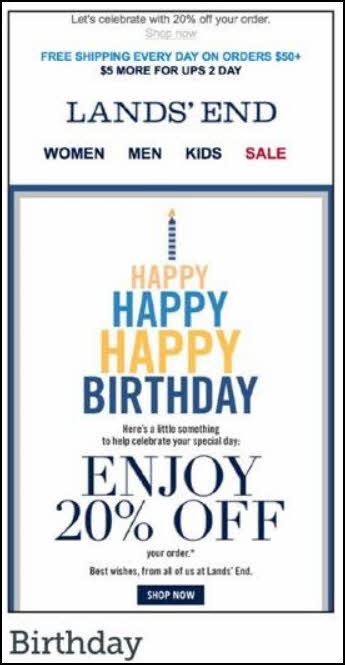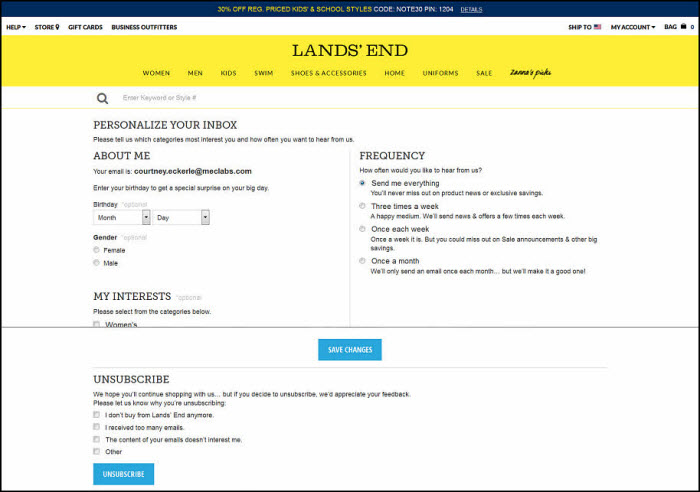by
Courtney Eckerle, Manager of Editorial Content
THE CUSTOMER
"Lands' End is definitely a classic American apparel brand," Lee Rennels, Director of Contact Strategy and Operations, Lands' End, said.
In 1963, it began as a sailboat equipment store in Chicago, publishing its first catalog the next year. Then, in 1977, the company published it first clothing catalog.
Rennels says today, "At our core, we're a direct-to-consumer company, generating most of our revenue either through digital channels or catalog."
Lands' End does have some retail presence in terms of stand-alone stores, he added, as well as a presence in Sears. However, most of the focus is on the direct-to-consumer model online and the catalog.
The Lands' End customer is typically female and is usually engaged in family-oriented shopping.
"We're proud to be the resource for all of her family. We also try to be the resource for her home needs as well," he said.
CHALLENGE
With a leadership change in the form of CEO Federica Marchionni, formerly of Dolce & Gabbana, the company is "definitely going through a phase of transitioning and growing our brand into different areas … But again, at our core, we're a classic American apparel brand, and we're in the growth phase right now," Rennels said.
Rennels runs the strategy and operations for the Lands' End CRM team. When he first started with the company, the email content strategy was more calendar-based with only basic triggers, such as cart abandonment.
When he came onboard, there were two issues that caused the team to look at quickly enhancing the trigger program.
First, even with the triggers already in place, there were holes in the program. The team was not capturing everyone who was eligible to receive various triggers.
Second, the team wanted to more carefully choose the right points in time to give customers value and acknowledge the most important aspects in their lifecycle.
"Because we're choosing the right points and using different attributes that are important to our customers, we're actually seeing the retention rate increase where our unsubscribes have actually decreased," he said.
The team was able to achieve this by implementing rules so customers don't receive two emails in one day despite the addition of more emails to the program.
CAMPAIGN
For this campaign, Rennels and his team audited their existing program and data to create trigger campaigns that would reach customers at the most relevant and meaningful times. Adjusting the frequency of current campaigns based on better data was another factor in this effort.
To do this, they also implemented mechanics such as a new preference center that would gather additional behavioral data to utilize in this campaign.
Step #1. Audit existing program
"When you first look at a program that's already existing, you want to do an audit," Rennels said, adding that, "I hate to use this cliché, but you look for low-hanging fruit."
That process involved asking themselves if the right mechanisms were in place to capture everyone who was eligible for a specific trigger. The answer: "That wasn't in place," he said.
From there, Rennels said he began looking into a series of questions:
- Are there certain data points, attributes or behaviors that should be a core part of any good trigger-based program?
- Are those being capitalized on?
- Do we have those in place?
In the audit, already existing triggers were found.
"What you want to do is obviously then take a look at those," he said, asking, "Is the messaging correct? Are we using the right data to then trigger those messages?"
The goals with this audit were to make sure that the team was filling in any holes and to ensure existing methods used the correct data and messaging.
Even with some triggers already in place, the program had holes, Rennels said. The team was not capturing everyone who was eligible to receive various triggers, such as abandoned cart.
"We put in the right tracking mechanisms to track someone and make that tracking persistent for a year versus just that session … So, we were scaling up the current triggers," he said, explaining that the goal was to take full advantage of what was already in place.
Then, the team looked to enhance the program and look deeply at basic customer behaviors and attributes that weren't being taken advantage of. A simple example of this, he said, was implementing a birthday trigger.
"We have that data point for our customers, but we weren't using it. It's also a great time to build a relationship. So, it's not just about driving incremental revenue, but it's also trying to build a relationship with our customers and really acknowledging certain points in their own personal lifecycle that are important to them," he said.
The main point was to enhance the customer information Lands' End already had, and make simple program additions based on customer attribute data that was already on file.
Step #2. Prioritize workload
"The next thing is really to prioritize all those tasks ... We need to drive demand on top of building those relationships," Rennels said.
Heading into the implementation phase, the team focused prioritization on two factors: changes that would produce a return and changes that could also be implemented quickly.

Click here to see the full version of this creative sample
For instance, the team created a
welcome email, anniversary email and
birthday email.

Click here to see the full version of this creative sample
While they focused on efforts that could be implemented quickly, each new email still required many steps.
"It's still a laborious effort because you have the creative aspect, you have the back end aspect of … making sure that all the data and the feeds were being sent to the right places and set up," he said.
There were some instances, he added, where the data was available, but the mechanisms in place weren't feeding the messaging. Alternately, sometimes data was available but the team didn't have access to it, and they had to work with IT partners to gain access.
"We had to … get access to it and then make sure it's being fed into the right places to then feed our messages," he said. "So, really it's sitting down, looking at a data map and figuring out where those are. Then, if the feeds are not in place, we work with [our vendor] to get those in place."
Step #3. Adjust frequency
"What's really great about Lands' End … we have a very, very loyal customer base. We hear from them good and bad. But where that helps us is they don't mind hearing from us as long as we're delivering value and good content to them," Rennels said.
What came from a deep frequency analysis done accessing data and gaps in the email program was that the team discovered that they could send up to three emails in a day without seeing any adverse effects.
"We really capped it at three, but not three of the same kind obviously. We just knew that within a given day, if someone receives a trigger, a transactional and a promotional, we're not going to see any adverse effects from that," he said.
When the email frequency has to scale down, he added, they prioritize triggered emails first — since they are based off of a specific behavior by that customer — and transactional sends last.
"In our instance, we did the analysis. We saw that people were not opting out at a higher rate. We saw that an incremental benefit from setting those three in a given day far outweighed any negative impact for our file, which were actually nonexistent," Rennels said.
He advised that in areas where customers are more sensitive, marketers might not be able to keep up that frequency, but "you look at your data. If your data is telling you you're okay to do that, [you can]. That's exactly what we saw and what we continue to do."
Marketers have to be careful not to bombard their customers, he added, and protect opt-out rates.
"If you're choosing the right points in time and giving them value and acknowledging really important aspects in their lifecycle, even though we added more emails … we're actually seeing the retention rate increase where our unsubscribes have actually decreased," he said.
Preference center changes
Previously, if someone wanted to unsubscribe from Lands' End emails, they simply followed the link at the bottom of the email, and they weren't given any other options.
"It was an easy unsubscribe. Great experience for the customer; however, there's a lot of effort and a lot of resources to acquiring even just one email address," he said.

Click here to see the full version of this creative sample
Lands' End implemented
a subscription preference center where customers were given options for frequency of emails.
"We also gave them options to choose — 'Okay, what are you most interested in? — that we used for segmentation," he said.
Providing the opt-down option — instead of just unsubscribing — "helped us tremendously," he said, adding that unsubscribe rates went down 20%.
"People were opting down, but we were not losing them from our file," he said. "You're giving the power to the customer, and they still want to receive certain things. They just don't want to receive everything. We're simply asking them."
RESULTS
The biggest thing for Lands' End, Rennels said, was ensuring that everything from data to trigger mechanisms worked in cohesion.
"We had a pretty solid program in place. But we found new data elements and touch points," he said. "But the big takeaway was, as long as you're choosing the right reasons to communicate with your customers and you're giving them real value — not just value in terms of promotions and so forth, but also good content — [then] you're pretty safe in terms of communicating with them."
The new and improved Lands' End triggered campaigns have generated:
- 9% of email-driven revenue
- 9% of email-driven orders
- 12% of email-driven website visits
"You monitor all the KPIs to make sure that you're not overdoing it. But as long as you're giving them the right time, the right content and value, at least for Lands' End, our customers do respond positively to that," he said.
Creative Samples
- Welcome email
- Birthday email
- Subscription preference center
Sources
Lands' End Yesmail — vendor for Lands' End
Related Resources
MarketingSherpa Summit 2016 — At the Bellagio in Las Vegas, February 22-24
Email Marketing: List segmentation tips using social media and online behavior [From the MarketingSherpa blog]
Email Marketing Segmentation: Clothing brand uses social behavioral data to drive a 141% increase in revenueCRM and the Marketing Database: Data hygiene, behavioral analysis and more












